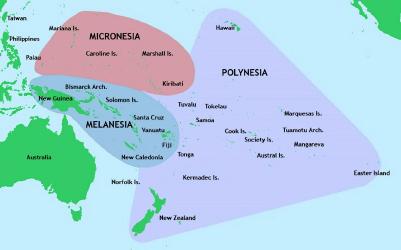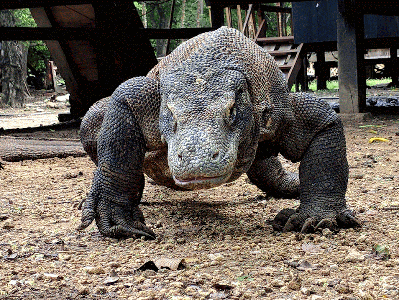Island hopping across the South Pacific − 9 April 2018
East and south of New Guinea are hundreds of islands,
spread out over an area that's almost as large as Australia.
It would be a fantastic adventure to sail to every one of these islands,
to anchor inside every lagoon,
and to meet the people who live there.
But, that would take years.
In the interest of time, I traveled by air, hopping down this chain of emerald isles.
Distance and isolation have led to each island evolving its own culture.
In the 18th and 19th centuries, European colonization re-shaped each island's economy and demographics.
Then, World War II brought changes that affected some of these islands dramatically.
Today, it's no surprise to find that each island is unique.
|

|
Vanuatu
From the Solomon Islands, I hopped to Port Vila, the capital of Vanuatu.
Vanuatu consists of 83 frangipani-scented islands.
Thatched roof villages are nestled under palm trees beside turquoise lagoons ringed by golden beaches.
The reefs are full of tropical fish and turtles.
The menu features fresh fish cooked in coconut milk.
Yet, all is not perfect in this South Pacific paradise.
Vanuatu sits on the leading edge of the Pacific Plate, on top of a subduction zone.
There are nine active volcanoes.
Port Vila is the world's most exposed capital to natural disasters.
Cyclones,
earthquakes,
volcanic activity,
and
tsunamis
strike regularly.
In 2015, Cyclone Pam wiped out 95% of Vanuatu's homes,
along with vital crops and plantations.
When I arrived here, there were still broken boats beached on the shoreline.
|
|
Until its independence in 1980, Vanuatu was known as the New Hebrides Islands,
a territory claimed by both France and England.
The New Hebrides were governed by an unusual Anglo-French system in which
there were
two health services,
two education systems,
two currencies,
two police forces,
and
two prison systems.
Overseas visitors had to opt for either British or French authority.
British law was stricter, but the British jails were considered more humane.
The French jails were very uncomfortable, but the food was better.
The English population drove on the left-hand-side of the road, while the French population drove on the right.
And yes, this caused a bit of a problem.
When France fell during World War II,
the French side of the government was technically at war with the British half.
|
 Flag of the New Hebrides
Flag of the New Hebrides
|
|
In Port Vila, I lucked into an AirBnB apartment
upstairs from
Vanuatu's best dive shop.
Nautilus Watersports
offers wreck and reef diving, as well as deep-sea fishing.
From my balcony, I had a stunning view of Port Vila's harbor.
In the mornings, I could practically roll out of bed onto the dive boat.
|

The harbor in Port Vila, Vanuatu
|

A woman with her dinner
|
Vanuatans are friendly.
They speak a mix of pidgin French and English.
Every island in Vanuatu has its own language, culture, masks, dances and rituals.
If you had a few months to spend here, you might be able to visit them all,
see wonderful scenery,
bargain for shell jewelry,
attend a few festivals,
and
paddle an outrigger canoe.
With only a few days, I had to be satisfied with the
collection of traditional artifacts
at the
Vanuatu National Museum in Port Vila.
|
 Tamtams (slit drums)
Tamtams (slit drums)
|

Ceremonial festival mask
|
|
Vanuatu has some unusual beliefs and rituals.
Yam cultivation is at the center of the village culture.
Yam farming determines the cycle of the year.
Months are named after yams.
One of the highlights of the Yam Festival on Pentecost Island is
land diving (Nahgol or N'Gol).
Men make spectacular leaps from high towers as a gift to the gods to ensure a bountiful yam harvest.
The ropes are made of liana vines tied around the ankles.
There is no safety equipment.
For a land dive to be successful, the man's hair must touch the soil
to fertilize the yam crop.
It's said that Vanuatu is where
the worldwide phenomenon of bungee jumping originated.
|

Land divers − the original bungee jumpers
|
|
One of Vanuatu's officially recognized religions is
the Cargo Cult of Tanna Island.
In the 19th century, Melanesians had occasional contact with more advanced societies who brought with them "divine gifts."
The Cargo Cult got a huge boost in World War II.
Anticipating a Japanese invasion,
the Americans arrived in 1942,
bringing with them supplies for thousands of troops.
With Japan’s defeat in 1945, the Americans withdrew, abandoning huge quantities of cargo.
The religious figurehead of this cult is an American soldier named John Frum.
("John Frum" is a corruption of "John from America.")
February 15 is John Frum Day in Vanuatu.
The John Frum movement has its own political party.
Today, followers of John Frum perform various rituals to encourage American airplanes to bring more "cargo."
They build symbolic landing strips,
march in parade ground drills with wooden or salvaged rifles,
carve headphones and wear them while sitting in fabricated control towers,
light signal fires to light up runways and lighthouses,
and
build life-size replicas of airplanes out of straw.
|

A John Frum airplane, made of thatch and bamboo
|

|
New Caledonia
New Caledonia is a French territory − but perhaps not for much longer.
The native Melanesians, who call themselves Kanaks,
have been protesting and fighting for their independence
ever since the French started taking away their tribal lands 150 years ago,
and forcing the Kanaks onto reservations in the mountains.
The French introduced the Kanaks to the guillotine in 1867.
On November 4, 2018, there will be a referendum to become an independent nation.
If a majority of the people vote for independence,
New Caledonia will be our planet's next new country, named Kanaky.
If they vote no
− as most of the city-dwellers hope they will −
then New Caledonia will continue to have its roads, schools, postal services and security paid for by France.
In either case, someone will benefit from the fact that
this island has 25% of the world's nickel deposits
and a thriving tourist economy.
|

European architecture in the capital city of Noumea
|

Gardens, statues and fountains in Place des Cocotiers
|

Girl selling fish at the market
|
Coming from primitive Vanuatu,
I was amazed to arrive someplace with
multi-story buildings,
4-lane highways,
24-hour electricity,
and
fast wifi.
The capital city, Noumea,
has a sophisticated European air.
There are
sidewalk cafes,
a cathedral on the hill,
a waterfront filled with million-dollar yachts,
a central city plaza with statues, fountains and benches,
gourmet food beneath palm trees,
and
beautiful beaches lined with resorts and bungalows.
The urban population is a multi-national mix of
Asians,
Europeans
and
Melanesians.
All the signs are in French.
About half the people speak English as well.
Like Vanuatu and the Solomon Islands,
there's a lot of World War II history here.
Between 1942 and 1945, more than one million Allied soldiers
− mostly Americans −
passed through Noumea.
|

Gentlemen wiling away the afternoon in the park
|

St.Joseph's Cathedral and Jean d'Arc
|

A Kanak chief's house
|
I learned about the Kanak culture at the beautiful and iconic
Tjibaou Cultural Centre.
The Kanaks are a mix of the ancient Melanesian settlers and the seafaring Polynesians.
They worship their ancestors.
They have rich traditions of fishing, wood carving, drumming and dancing.
In Kanak villages,
life centers around the grande case,
the chief's hut.
The roof is designed to allow smoke to go up and to keep out the heavy rains.
Fierce warriors guard the entrance.
Today,
Kanaks are
a marginalized segment of New Caledonia's population.
They comprise 39% of the island's population,
but are a majority of the prison population.
Will they get their independence in November?
This is a big question in New Caledonia.
|

Warriors guarding the chief's house
|

|
Fiji
My last stop in Melanesia was Fiji.
From its flag, it's easy to see that this was a former British colony.
Fiji is a thriving, independent nation.
If paved roads,
good schools,
clean drinking water,
and
direct flights to LA
are an indication of success,
Fiji is the most modern and successful country in Melanesia.
Fiji's success has a lot to do with a
well-established tourist industry and
plenty of foreign investment.
I saw more tourists in Fiji than I've seen anywhere in the past two months except for Bali.
Many expats come here from Australia and New Zealand
to start businesses,
build homes,
and
eventually retire.
Fiji enjoyed lots of media attention in recent years.
Tom Hank's Cast Away
and the 1980 classic The Blue Lagoon
were filmed here.
Fiji won its
first ever gold medal in Rugby Sevens in Rio in 2016.
|
|
I came to Fiji for one thing: To go shark diving.
Many shark species are endangered.
The Chinese eat a lot of shark fin soup.
Often sharks are caught,
their fins cut off,
and then dropped back into the sea to die.
Some shark populations have declined over 90% in the past 40 years.
On Fiji's south coast, Beqa Adventure Divers
has created a shark conservation program.
For $200, you dive twice to a depth of about 20 meters
to watch shark handlers feed tuna heads to bull sharks and reef sharks.
Part of your dive fee goes to the local villagers
who have agreed not to hunt sharks or to fish in their habitat.
|

Click the photo to see the video
|

Surrounded by playful bull sharks, average length ~3 meters
|
|
By turning a shark habitat into a commercial operation,
the organizers make enough money to pay the local fishermen not to fish in this channel,
to patrol the area to keep international shark hunters out,
and to support research on shark biology and behavior.
This is not unlike how
the mountain gorillas in Uganda
or
the elephants of Kenya
are protected.
It's enough of a money-making tourist attraction that the community at large supports it.
Naturally, the animals become somewhat habituated to humans,
but at least they're alive.
Thanks to this program, Fiji's shark population is growing.
On the morning that I was there, I was in a group of about 15 divers.
Our group crouched or lay down on the sandy bottom.
I counted 24 adult bull sharks, plus a few dozen reef sharks.
Some of the sharks were close enough that their fins and tails brushed my head as they swam over me.
Wow!
|

School boys enjoying their assigned reading
|
Fiji’s greeting "Bula" is more than just "Hi."
It literally translates as "Life" −
an apt salutation from a spirited people who seem to live theirs to the fullest.
The children are especially friendly.
It must be wonderful to grow up in a world where it's always summer and the beach is a 10-minute walk away.
|

The cyclone that cut my visit to Fiji short
|
|
I would like to have stayed in Fiji a little longer.
But March and April are cyclone season in the southern hemisphere.
Instead of hunkering down for a few days of torrential rains until the cyclone blew over and the airport could be reopened,
I opted to fly out before cyclone Keni hit Fiji.
|

Melanesian fishermen throwing their nets
|
From Fiji, it's a 10-hour flight across 4 time zones to Singapore.
From there, I flew 2 more hours across 1 more time zone to get to Bangkok.
This is a good measure of
how big Melanesia is
and
how far I've traveled in the past two months.
Now, I'll spend a month "at home" in Thailand checking on the bakery ...
while I plan my next adventure.
|
|



















































































 Flag of the New Hebrides
Flag of the New Hebrides



















